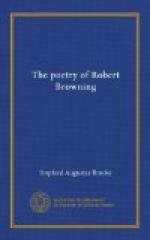So, too, it was when Turner recreated landscape art. There was the perfect Claudesque landscape, with all its parts arranged, its colours chosen, the composition balanced, the tree here, the river there, the figures in the foreground, the accurate distribution and gradation of the masses of light and shade. “There,” the critics said, “we have had perfection. Let us rest in that.” And all growth in landscape-art ceased. Then came Turner, who, when he had followed the old for a time and got its good, broke away from it, as if in laughter. “What,” he felt, “the infinite of nature is before me; inconceivable change and variety in earth, and sky, and sea—and shall I be tied down to one form of painting landscape, one arrangement of artistic properties? Let the old perfection go.” And we had our revolution in landscape art: nothing, perhaps, so faultless as Claude’s composition, but life, love of nature, and an illimitable range; incessant change, movement, and aspiration which have never since allowed the landscape artist to think that he has attained.
On another side of the art of painting, Rossetti, Millais, Hunt arose; and they said, “We will paint men as they actually were in the past, in the moments of their passion, and with their emotions on their faces, and with the scenery around them as it was; and whatever background of nature there was behind them, it shall be painted direct from the very work of nature herself, and in her very colours. In doing this our range will become infinite. No doubt we shall fail. We cannot grasp the whole of nature and humanity, but we shall be in their life: aspiring, alive, and winning more and more of truth.” And the world of art howled at them, as the world of criticism howled at Wordsworth. But a new life and joy began to move in painting. Its winter was over, its spring had begun, its summer was imagined. Their drawing was faulty; their colour was called crude; they seemed to know little or nothing of composition; but the Spirit of Life was in them, and their faults were worth more than the best successes of the school that followed Rafael; for their faults proved that passion, aspiration and originality were again alive:
Give these, I exhort you,
their guerdon and glory
For daring so
much, before they well did it.
If ever the artist should say to himself, “What I desire has been attained: I can but imitate or follow it”; or if the people who care for any art should think, “The best has been reached; let us be content to rest in that perfection”; the death of art has come.




